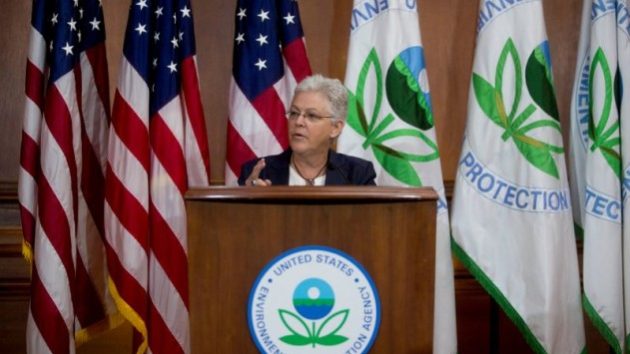EPA Pumps Up Benefits of Proposed Carbon Regulation
EPA argues that its proposed carbon regulations on existing power plants will offer $30 billion in climate benefits by 2030 with only $7.3 billion in costs. Sounds like a great deal, right? Not so fast.
A Brookings Institution white paper finds that EPA pumped up that number by including global climate benefits. If the agency took the standard approach and only examined the costs and benefits to those in the United States—who will feel its full brunt —then the climate benefits from the proposed rule would fall to as little as 7% of what EPA estimates, much less than the proposed regulation’s costs.
Authors Ted Gayer, Vice President and Director, Economic Studies at the Brookings Institution and Kip Viscusi, law professor at Vanderbilt University, explain that a basic component to cost-benefit analysis is looking at the appropriate population:
The pertinent populations that are attributed standing in a benefit-cost analysis should correspond to the political jurisdiction that is bearing the cost.
For example, when analyzing a new Wisconsin milk regulation, one should include the regulation’s effects on Wisconsin farmers and milk drinkers and not on those living in Florida.
Likewise, the cost-benefit analysis of EPA’s proposed carbon should be limited to the United States, but that’s not what EPA is doing. Gayer and Viscusi write [emphasis mine]:
The recent governmental analyses of the benefits associated with reduction of [greenhouse gas] emissions represent a rare instance in which U.S. regulatory impact analyses have used a worldwide benefits reference point rather than a U.S. reference point.
The only other time the authors could find an instance of this was in 1980 involving a uranium regulation.
Why is EPA doing this? Because it’ll make the proposed rule more politically palatable, write Gayer and Viscusi:
[I]mposing a global perspective on benefits will increase the apparent desirability of the policy but will overstate the actual benefits to the American people.
However, EPA’s use of global benefits as the justification for the proposed carbon rule crosses Presidential Executive Orders that state that cost-benefit analyses should be limited to the effects on the American public. For instance, President Clinton’s Executive Order 12866 reads: [emphasis mine]
The American people deserve a regulatory system that works for them, not against them: a regulatory system that protects and improves their health, safety, environment, and well-being and improves the performance of the economy without imposing unacceptable or unreasonable costs on society…
President Obama’s Executive Order 13563 is along those same lines: [emphasis mine]:
Federal agencies should promulgate only such regulations as are required by law, are necessary to interpret the law, or are made necessary by compelling public need, such as material failures of private markets to protect or improve the health and safety of the public, the environment, or the well-being of the American people.
In addition, guidance from the Office of Management and Budget (OMB) advises regulators that
Your analysis should focus on benefits and costs that accrue to citizens and residents of the United States. Where you choose to evaluate a regulation that is likely to have effects beyond the borders of the United States, these effects should be reported separately.
The U.S. Chamber and several other trade associations have been arguing this exact point. “Consistent with OMB guidance, the costs of a rule for entities in the United States should be presented in comparison with the benefits occurring in the United States,” states a comment to OMB on the administration’s social cost of carbon estimates.
Gayer and Viscusi go on to write, “If one were to focus on the domestic benefits rather than the worldwide benefits, the [greenhouse gas] benefit component would sometimes be extremely small.”
How small? The Obama Administration estimates that most of the climate benefits of reducing carbon emissions would be outside the United States. “Only 7 to 23 percent of these benefits would be domestic benefits,” write Gayer and Viscusi. This means that “the domestic benefits amount [of the proposed carbon rule] is only $2.1 billion-$6.9 billion, which is less than the estimated compliance costs for the rule of $7.3 billion.”
EPA should be honest with the American people. Based on its own estimates, the costs of the proposed carbon rule–job losses, higher electricity costs, and a less-reliable electrical grid–outweigh its domestic climate benefits. The proposed rule is bad enough, but the misleading way EPA is justifying it is just as bad.
UPDATE: Michael Bastasch at the Daily Caller News Foundation pulled out a few more interesting quotes from the paper:
“If global consequences are permitted to govern the terms of the benefit-cost analysis, then the selection of policy initiatives likewise should be governed by global considerations, subject to compliance with U.S. law,” argue Gayer and Viscusi.
“Whether it makes sense to routinely expand the scope of the assessed policy impacts beyond the citizenry of the nation bearing the costs is highly problematic,” the authors write. “What is clear at this juncture is that the recent expansion of [greenhouse gas] benefit assessments to include global impacts merits much more scrutiny and justification than it has received to date.”
Follow Sean Hackbarth on Twitter at @seanhackbarth and the U.S. Chamber at @uschamber.
RELATED ARTICLE: Begich Earmarked Millions for Bankrupt Green Energy Company
RELATED VIDEO:
[youtube]http://youtu.be/CpJhJW0rvbg[/youtube]
EDITORS NOTE: The featured photo of EPA Administrator Gina McCarthy is courtesy of photographer: Andrew Harrer/Bloomberg.


